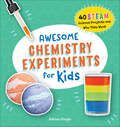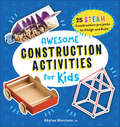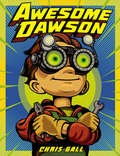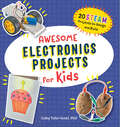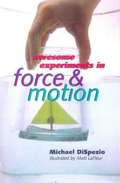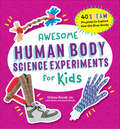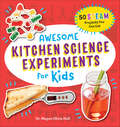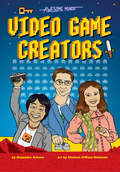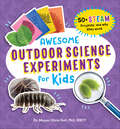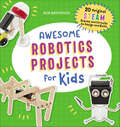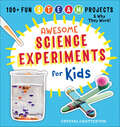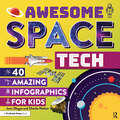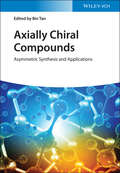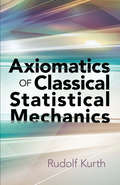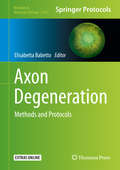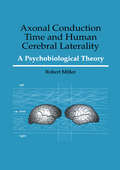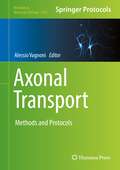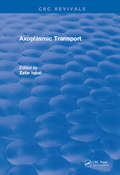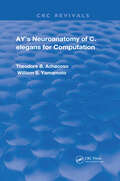- Table View
- List View
Awesome Chemistry Experiments for Kids: 40 STEAM Science Projects and Why They Work (Awesome STEAM Activities for Kids)
by Adrian DingleChemistry comes alive with hands-on science experiments for kids ages 5 to 10The world of chemistry is packed with awesome ways for kids to learn and play! Filled with colorful and gooey fun, these science experiments for kids are sure to get them interested in discovering how different substances react together.Whether it's creating fizzy bath bombs or making batteries out of coins, each of these science experiments for kids provides a simple hypothesis and the guidance they need to test it out for themselves.Go beyond other science books for kids with:40 fun chemistry experiments—Introduce kids to real chemistry with experiments that they can do at home using easy-to-find materials—and an adult assistant.Kid-friendly explanations—Ensure young scientists are getting the most out of the experiments with simple breakdowns of exactly what happened, why, and how it connects to STEAM.A handy mess-o-meter and more—Pick the perfect experiment with helpful labels that detail the difficulty, time needed, and the amount of cleanup.Foster a lifelong love of scientific exploration with these amazing science experiments for kids.
Awesome Construction Activities for Kids: 25 STEAM Construction Projects to Design and Build (Awesome STEAM Activities for Kids)
by Akyiaa MorrisonConstruction comes alive with hands-on activities for kids ages 5 to 10Kids love construction! From bridges to buildings, this book is filled with incredible things that young engineers can design and build themselves. They'll learn how structures are built, what goes on at construction sites, and the ways simple materials like rocks and dirt helped create our modern world. This book keeps kids on track with step-by-step instructions for building paper cup towers, railroads, and more. They'll find out about the infrastructure that makes up our neighborhoods while also discovering how science, technology, engineering, art, and math all play important parts in construction.Go beyond other construction books for kids with:25 inspiring activities—Introduce kids to real construction with projects they can build at home using easy-to-find materials and an adult assistant.Kid-friendly explanations—Expand the learning with simple explanations of how activities connect to STEAM concepts, as well as the hows and whys behind each project.Info at a glance—Pick the perfect project with handy labels that detail the difficulty of the build, the time needed, and all necessary materials.Foster a lifelong love of building with this standout among kids' construction books.
Awesome Dawson
by Chris GallEVERYTHING CAN BE USED AGAIN! That's Dawson's motto. He collects junk that people throw away and turns it into something STUPENDOUS. But when Dawson uses his skills to create a machine to do his chores for him, he discovers he might have invented something a littletoo. . . AWESOME. Can he stop the rampaging robot before it destroys the entire town? Chris Gall inspires kids to reuse, repurpose, and recycle in this inventive adventure about a boy superhero who turns trash into treasures--and saves the world while he's at it!
Awesome Electronics Projects for Kids: 20 STEAM Projects to Design and Build (Awesome STEAM Activities for Kids)
by Colby Tofel-GrehlElectronics come alive with hands-on activities for kids ages 5 to 10The world of electrical engineering is packed with awesome ways for kids to learn and play! Filled with glowing, buzzing, and spinning fun, this guide to electronics for kids helps them fall in love with science as they explore the mechanics behind everyday devices.Whether it's a light-up birthday card, an automated bubble blower, or an alarm clock, every project features easy-to-find components and simple directions that give kids the guidance they need to build. Expand their learning with explanations of how these electronics for kids connect to larger STEAM ideas!This collection of buildable electronics for kids features:20 fun builds—Introduce the science behind electronics for kids through projects that they can do at home with affordable materials—and a little adult supervision.Educational explanations—Go beyond other electronics books thanks to simple breakdowns of exactly what happened and why, ensuring kids get the most out of each activity.Progressive difficulty—Discover electronics for kids that start simple and get more challenging as they go, helping young learners grow their skills without getting frustrated.Inspire a lifelong love of science (plus technology, engineering, art, and math) with the super fun activities in Awesome Electronics Projects for Kids.
Awesome Engineering Activities for Kids: 50+ Exciting STEAM Projects to Design and Build (Awesome STEAM Activities for Kids)
by Christina Herkert SchulSpark creativity and curiosity with fun engineering activities for kids ages 5 to 10Watch your child's eyes light up as they get excited about engineering, learn how things work, and have tons of fun. Awesome Engineering Activities for Kids is packed with more than 50 fascinating STEAM exercises, complete with step-by-step instructions, colorful pictures, and simple explanations of why the experiments work.This engaging book about engineering for kids includes:Activities kids can do themselves—Make engineering for kids easy and fun with projects like toothpick towers and paper cup phones that use common, inexpensive household materials so they can play and learn anytime.The power of STEAM—Lessons are based in Science, Technology, Engineering, Art, and Math to show kids how these things are everywhere, and help them become better problem solvers and logical thinkers.The basics of engineering—Kids will learn all about engineering with a brief guide to the different types of engineers, an explanation of what they do, and what kids need to know to become one.Unlock the world of engineering for kids with exercises that help them learn, grow, and get creative.
Awesome Experiments in Force and Motion
by Michael DispezioThe force is with us -- as these experiments in force and motion prove! * Demonstrate inertia with a card shot trick. * Use a cardboard rocket ship to find the center of gravity. * Make your own "great salt lake" to display buoyancy. * Show the push and pull of air currents with a water tower. * Create "motion madness" with balloon cars. Ordinary, easy-to-find materials are all you need to get moving on these fun-filled investigations. Consistent with the National Science Education Standards
Awesome Human Body Science Experiments for Kids: 40 STEAM Projects to Explore How the Body Works (Awesome STEAM Activities for Kids)
by Orlena Kerek Galen Krek Dante KrekShow kids how the human body works—hands-on experiments for ages 5 to 10The human body is amazing! We use it to move, smell, taste, and speak—but how? Kids will uncover the answers with this book of 40 at-home science experiments. They'll see body systems in action with activities like building a digestive tract from socks and pantyhose, sculpting red blood cells, and making vocal cords out of rubber bands. Get kids thinking like a scientist as they answer questions during each experiment and take notes on what they learn. Best of all, kids will see their knowledge grow as they apply their new skills to progressively more challenging activities. Kid-friendly instructions—Step-by-step guidance and detailed diagrams make these projects easy enough for kids to do with minimal supervision. No special equipment required—These projects use inexpensive, everyday items like cotton balls, glass jars, and vinegar, so kids can get started right away. The S.T.E.A.M. connection—Discover how each activity fits into the world of science, technology, engineering, art, and math. Pick up this book today and explore tons of questions about the human body for kids.
Awesome Kitchen Science Experiments for Kids: 50 STEAM Projects You Can Eat (Awesome STEAM Activities for Kids)
by Megan Olivia HallInspire kids to get excited about science with edible experiments for ages 5-10. Discover hands-on experiments that encourage kids to get involved in science. With results they can eat, they'll find learning irresistible! Awesome Kitchen Science Experiments for Kids is full of food-related experiments that kids can literally sink their teeth into. Each chapter puts a new STEAM subject on the table, giving young learners a taste of science, technology, engineering, art, and math in delicious ways to use their brains.An age-appropriate introduction to the scientific method empowers kids to form hypotheses and test their theories. The experiments are rated for difficulty and potential mess, so adults know how much supervision is required. Easy-to-follow instructions ensure educational—and edible!—results.SOLAR-POWERED S'MORES: Learn about energy from the sun and build a solar oven out of a cardboard box. Then it's time to cook and enjoy s'mores in the sunshine!WHAT STOPS ONION TEARS?: Discover why people cry when they cut onions, and design an experiment to test preventative methods. What happens when the onions are cooked?EDIBLE DYES: In this artistic project, create a homemade dye by simmering beets, and find out the secret to getting the brightest colors from plant-based dyes.Feed kids' science curiosity with Awesome Kitchen Science Experiments for Kids. Help them become scientists and chefs at the same time!
Awesome Minds: Video Game Creators (Awesome Minds)
by Alejandro Arbona Chelsea O'MaraDid you know that Nintendo started in the mid-19th century as a playing card company and that the Japanese giant also sold rice and operated taxi cabs? And did you know that the very first video game was called Tennis for Two and was created by a US government scientist named William Higinbotham? <P><P>Today, video games play a gigantic role in our culture and none of this would have been possible without people like Shigeru Miyamoto, the creative mastermind that turned a failed business venture into the game that eventually inspired him to build Donkey Kong and Mario Bros., or Donna Bailey, who created the arcade video game sensation Centipede. <P><P>With full-color illustrations and lively text, and chock-full of interesting facts, Awesome Minds: Video Game Creators tells the stories of these amazing men and women who turned a small hobby into a multimillion-dollar industry that changed the way we play and interact, from our living rooms to the arcades, on our computers to our handheld devices. Awesome Minds: Video Game Creators is the perfect read for those with creative spirits, curious minds, and a love of technology and video games.
Awesome Outdoor Science Experiments for Kids: 50+ STEAM Projects and why they work (Awesome STEAM Activities for Kids)
by Megan Olivia HallExplore the outdoors with hands-on science activities for kids ages 5 to 10Kids are full of big questions like "What makes plants grow?" or "Why does the moon change shape in the sky?". Awesome Outdoor Experiments for Kids can help them find the answers! It's a treasure trove of outdoor adventures, with more than 50 fun experiments that show kids science in action as they play outside.Every experiment focuses on at least one aspect of STEAM: science, technology, engineering, arts, and math. As kids explore each activity outdoors, they'll get the chance to interact with nature and the amazing processes that are happening all around them. They'll observe bug behavior, build a beaver dam, predict the weather, and so much more.Discover the ultimate guide to an outdoor science lab for kids:Easy to do at home—The activities use basic items that are probably already around the house and include easy-to-follow steps.Hows and whys—Kids will learn the real science behind every result with simple explanations of what happened, tips for exploring more, and fascinating questions to think about.Just for kids—Little ones might need a little help from a grown-up for certain steps, but these experiments are designed for kids to do all by themselves.Get kids outdoors with a book of hands-on experiments that show them the power of nature!
Awesome Physics Experiments for Kids: 40 Fun Science Projects & Why They Work! (Awesome STEAM Activities for Kids)
by Erica L. ColónGet kids excited about physics with fun and easy experiments for ages 10 to 13 Turn living rooms into STEAM laboratories and watch as children have an awesome time learning about physics. This book contains 40 highly entertaining, hands-on experiments that can be completed using simple, household materials.What sets this physics for kids book apart:Excellent explanations—Brief explainers address the hows and whys of each experiment, providing children with a clear understanding of the fundamental concepts surrounding force, flight, and much more.Step-by-step instructions—Full-color photos and easy-to-follow instructions allow kids to confidently conduct experiments on their own, with only the occasional assist from an adult.Extended fun—Each experiment contains a "Now Try This!" section that offers ideas for further investigation and expands the possibilities for learning.Help kids set off on a journey of scientific discovery with 40 fun physics experiments they can tackle at home.
Awesome Robotics Projects for Kids: 20 Original STEAM Robots and Circuits to Design and Build (Awesome STEAM Activities for Kids)
by Bob KatovichBuild your own amazing robots—20 STEAM projects for kids 5 to 10!Get ready to build all kinds of incredible robots—right in your own home! Designed for young robot builders, these do-it-yourself robotics for kids projects will teach you about science, technology, engineering, art, and math (STEAM) as you assemble an amazing collection of real working robots!From scribblebots to two-legged walkers, this book walks you through robotics for kids, one beautifully-photographed project at a time. The robots start out simple and get more advanced as you go, helping you boost your skills (and your confidence) at the same time. Get started today!This exciting guide to robotics for kids includes:20 awesome projects—Rock the world of robotics for kids with nearly two-dozen different designs for bots that glow, draw, walk, climb, and more.Full-color photos—Construction is easy thanks to clear directions and 200 step-by-step pictures that help you build your robot right.Robots in the world—Chapters are divided based on the functions of robots, showing you how they can be used to help in your day-to-day life.Discover one of the most fun ways to get into robotics for kids!
Awesome Science Experiments for Kids: 100+ Fun STEAM Projects & Why They Work! (Awesome STEAM Activities for Kids)
by Crystal ChattertonThe ultimate science experiment book for kids! 100+ hands-on projects to get kids ages 5 to 10 excited about science.As kids grow older, they become more curious about the world around them, often asking, "How does this work?" Awesome Science Experiments for Kids teaches young brains the nuts and bolts of the scientific method using fun, hands-on experiments designed to show kids how to hypothesize, experiment, and then record their findings.It's great for fun anytime, but especially for turning your child's summer break into a period of fun-filled summer learning! With awesome projects like a Fizzy Rocket, Magnet-Powered Car, and Pencil Sundial, kids will have a blast learning to build, design, and think critically—while getting inspired to interact with the world around them and make their own discoveries. An amazing summer learning workbook, it guides young readers through numerous exciting projects that demonstrate the elegance and wonder of science in the most enjoyable way possible.Awesome Science Experiments for Kids includes:100+ STEAM experiments—Each activity includes an explanation of the processes in play, so kids can understand how and why each project works.Easy instructions—These step-by-step science experiments for kids simplify each process to make the projects fun and simple to understand—and they only require basic household materials.Colorful photos—Refer to real-life photos that show you how to bring these experiments to life.From learning how quicksand works to turning a lemon into a battery, these experiments teach budding STEAM kids how cool it is to be curious.
Awesome Snake Science!: 40 Activities for Learning About Snakes (Young Naturalists)
by Cindy BlobaumFrom cobras and copperheads to pythons and boas, all types of snakes are covered in this book of 40 science experiments, art projects, and games that help budding herpetologists gain a greater appreciation for these slithering reptiles. Activities include making foldable fangs to learn how snakes' teeth and jaws work together; simulating cytotoxic snake venom while making a tasty snack using an everyday enzyme found in pineapple; and mimicking the sound a rattlesnake makes using a rubber band, a paper clip, and an envelope. Engaging, simple, and safe experiments teach kids about the biology of snakes, such as how they use their tongues and nostrils to detect smells, how they are cold-blooded and sensitive to subtle changes in temperature, and how they can detect the slightest vibrations or tremors. Kids do not need a snake for any of the activities and will delight in all the strange snake facts and gross-out projects such as Snake Stink--where they create their own signature stink and test how well it repels potential predators. Did you know . . . * Snakes do not need to be coiled to strike. They can strike from any position, even underwater! * Cobras and coachwhips are two of the few snakes that can move in a straight line forward while keeping their upper body raised off the ground. *Snake venom can actually help humans too! A blood pressure medicine was developed from the venom of a Brazilian pit viper, and over 60 other treatments have been created from snake venoms.
Awesome Space Tech: 40 Amazing Infographics for Kids
by Jennifer Dlugos Charlie HattonSpace may be the "final frontier"—but how do we learn about it, look deeper into it, and live in it? The infographics in this book will rocket you through a universe of powerful telescopes, distant probes, and high-speed spacecraft. Get ready to buzz by comets, land on alien planets, peer into the universe's past, and go where no one (except a handful of rovers and space probes) has gone before! We live in a complicated cosmos, but this book breaks down the complex, the confusing, and the downright kooky to reveal the fascinating details and hidden wonders that are out of this world.Ages 9-12
Axes of Sustainable Development and Growth in India: Essays in Honour of Professor Jyoti K. Parikh (Sustainable Development Goals Series)
by Piyush Tiwari Kirit ParikhThis book is written by prominent academics and practitioners, exploring problems and opportunities of growth in different aspects of sustainable development. The overarching themes running throughout the book are energy access, policy, climate change, human development and resource allocation in the context of India. The book will benefit policymakers and researchers with its inclusion of new evidence and solutions to meet developmental challenges.
Axial Turbine Aerodynamics for Aero-engines: Flow Analysis and Aerodynamics Design
by Zhengping Zou Songtao Wang Huoxing Liu Weihao ZhangThis book is a monograph on aerodynamics of aero-engine gas turbines focusing on the new progresses on flow mechanism and design methods in the recent 20 years. Starting with basic principles in aerodynamics and thermodynamics, this book systematically expounds the recent research on mechanisms of flows in axial gas turbines, including high pressure and low pressure turbines, inter-turbine ducts and turbine rear frame ducts, and introduces the classical and innovative numerical evaluation methods in different dimensions. This book also summarizes the latest research achievements in the field of gas turbine aerodynamic design and flow control, and the multidisciplinary conjugate problems involved with gas turbines. This book should be helpful for scientific and technical staffs, college teachers, graduate students, and senior college students, who are involved in research and design of gas turbines.
Axially Chiral Compounds: Asymmetric Synthesis and Applications
by Bin TanAxially Chiral Compounds Explore this comprehensive and current volume summarizing the characteristics, synthesis, and applications of axial chiralityAppearing widely in natural products, biologically active molecules, asymmetric chemistry, and material science, axially chiral motifs constitute the core backbones of the majority of chiral ligands and organocatalysts in asymmetric catalysis. In a new work of particular relevance to synthetic chemists, Axially Chiral Compounds: Asymmetric Synthesis and Applications delivers a clearly structured and authoritative volume covering the classification, characteristics, synthesis, and applications of axial chirality.A must read for every synthetic chemist practicing today, the book follows the development history, research status, and applications of axial chirality. An introductory chapter familiarizes the reader with foundational material before the distinguished authors describe the different classes and the synthesis of axial chiral compounds used in asymmetric synthesis.The book concludes with a focus on the applications of chiral ligands, chiral catalysts, and materials. Readers will also benefit from the inclusion of:A thorough introduction to asymmetric synthesis, including biaryls atropisomers, heterobiaryls atropisomers, and non-biaryls atropisomersExplorations of chiral allene, spiro skeletons, and natural productsPractical discussions of asymmetric transformation, chiral ligands, and chiral catalystsAn examination of miscellaneous applications of axially chiral compoundsPerfect for organic chemists, chemists working with or on organometallics, catalytic chemists, and materials scientists, Axially Chiral Compounds: Asymmetric Synthesis and Applications will also earn a place in the libraries of natural products chemists who seek a one-stop reference for compounds exhibiting axial chirality.
Axiomatics of Classical Statistical Mechanics (Dover Books on Physics #Volume 11)
by Rudolf KurthRequiring only familiarity with elements of calculus and analytical geometry, this monograph constructs classical statistical mechanics as a deductive system, based on equations of motion and basic postulates of probability. 1960 edition.
Axon Degeneration: Methods and Protocols (Methods in Molecular Biology #2143)
by Elisabetta BabettoThis book is a collection of classical as well as innovative methods used to investigate axon degeneration with a particular focus on addressing the common challenges encountered while performing these procedures. Particular attention is devoted to the study of axon loss in several model organisms, as each poses unique challenges and provides powerful advantages. Written for the highly successful Methods in Molecular Biology series, chapters include introductions to their respective topics, lists of the necessary materials, step-by-step, readily reproducible laboratory protocols, and tips on troubleshooting and avoiding known pitfalls. Authoritative and practical, Axon Degeneration: Methods and Protocols is an ideal guide for facilitating the application and further development of these protocols, which will help the scientific community tackle important questions regarding axon degeneration.Chapters 2, 3, and 20 are available Open Access under a Creative Commons Attribution 4.0 International License via link.springer.com.
Axonal Conduction Time and Human Cerebral Laterality: A Psycological Theory
by Robert MillerThis book takes a new and up-to-date look at the prominent theory that the left hemisphere is specialised for representing patterns extended in time whereas the right hemisphere represents simultaneous or 'spatial' patterns. What makes it unique in the field is that it looks at this theory from a neurobiological basis. It suggests that the difference resides in the range of conduction times in the axons connecting different regions of the cortex in each hemisphere. This hypothesis is discussed with respect to theoretical models of brain dynamics, and both gross and microscopic structure of the hemispheres. It deals with the psychological implications of the hypothesis for higher functions of the human cerebrum and outlines testable implications wherever possible.
Axonal Transport: Methods and Protocols (Methods in Molecular Biology #2431)
by Alessio VagnoniThis volume covers a wide range of model systems from invertebrate to humans and in vitro and in vivo. Chapters detail methods on squid, aplysia, xenopus, mouse in vivo, ex vivo, rodent primary neurons, human-derived neurons, zebrafish, drosophila in vivo, primary neurons, c. elegans, and in vitro reconstitution assays.Written in the format of the highly successful Methods in Molecular Biology series, each chapter includes an introduction to the topic, lists necessary materials and reagents, includes tips on troubleshooting and known pitfalls, and step-by-step, readily reproducible protocols. Authoritative and cutting-edge, Axonal Transport: Methods and Protocols aims to further our understanding of the trafficking of cellular components in the nervous system leading to the advancement of basic knowledge that underlines the cell biology of the neuron.The chapters “ Live imaging of RNA Transport and Translation in Xenopus Retinal Axons, Retrograde Axonal Transport of Neurotrophins in Basal Forebrain Cholinergic Neurons, Assessment of Mitochondrial Trafficking as A Surrogate of Fast Axonal Transport in Human Induced Pluripotent Stem Cell Derived Spinal Motor Neurons, Drosophila Primary Neuronal Cultures as a Useful Cellular Model to Study and Image Axonal Transport, and In vitro Reconstitution of Kinesin-Based, Axonal mRNA Transport” are available open access under a Creative Commons Attribution 4.0 International License via link.springer.com
Axoplasmic Transport
by Zafar IqbalAxoplasmic transport is the intracellular movement of cellular components required for the maintenance and normal physiological functioning of neuronal cells. This book provides an up to date reference for both established investigators as well as for those entering in the field.This volume describes the history and methods of the study of transport and the involvement of energy, ions, calmodulin, microtubules and other cellular components in transport. It also discusses the transport of polypeptides, lipids, nucleic acids, neutrotransmitter containing components and various other particles in nerve fibres. A significant portion of this book is devoted to axoplasmic transport, regeneration and the relevance of transport in neurotropic functions are described in the alst four chapters, followed by a discussion on the mechanism of axoplasmic transport.
Ay's Neuroanatomy of C. Elegans for Computation (Routledge Revivals)
by Theodore B. Achacoso William S. YamamotoFirst published in 1992, AY's Neuroanatomy of C. elegans for Computation provides the neural circuitry database of the nematode Caenorhabditis elegans, both in printed form and in ASCII files on 5.25-inch diskettes (for use on IBM® and compatible personal computers, Macintosh® computers, and higher level machines). Tables of connections among neuron classes, synapses among individual neurons, gap junctions among neurons, worm cells and their embryonic origin, and synthetically derived neuromuscular connections are presented together with the references from which the data were compiled and edited. Sample data files and source codes of FORTRAN and BASIC programs are provided to illustrate the use of mathematical tools for any researcher or student interested in examining a natural neural network and discovering what makes it tick.
Ayodhya: Archaeology After Demolition (Revised edition)
by D. MandalIt has been claimed that archaeological evidence provides irrefutable proof of the existence of a temple at the site of Ayodhya, and of the destruction of this temple by Babur.
